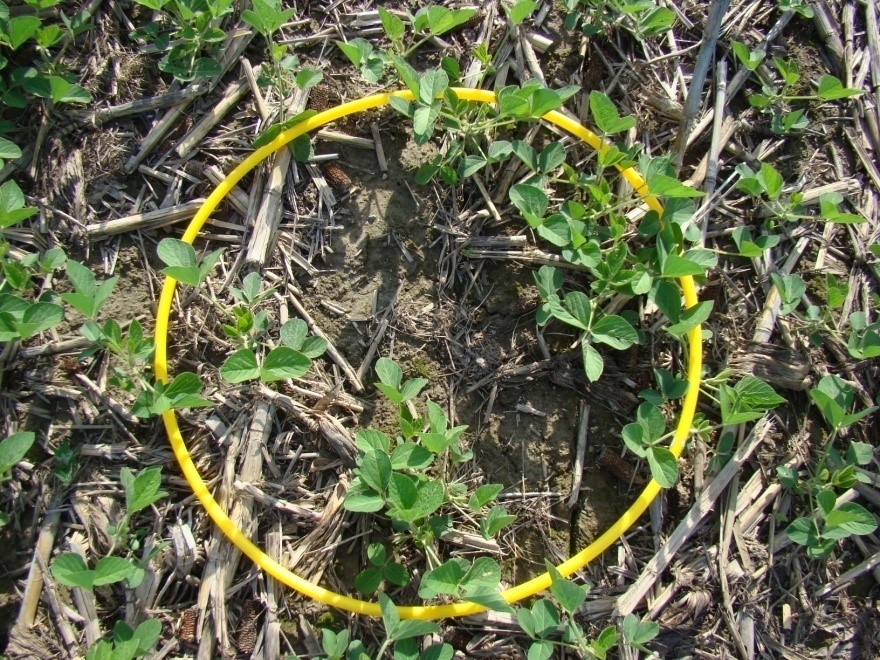Planting and stand establishment can be challenging
By Shaun Casteel,
Purdue University Extension Soybean Specialist
Planting and stand establishment can be one of the most trying parts of the growing season. March weather was wonderful, but the first half of April was frustrating with rainfall and a few cold snaps. Some fields were able to be planted in April followed by a few days in early May.
As the calendar marches forward, many of us can pull the trigger on planting in marginal conditions (myself included). That might cause some sidewall compaction or even open seed slots. Our spring has also brought periods of hard rains that can seal over the soil and cause crusting. All of these situations and more can compromise the establishment of soybean plants.
Our normal goal is 100,000 to 120,000 plants per acre to optimize yield and economics. However, we should not be quick to replant or overseed into an existing stand if the field is less than 100,000. Obviously, the distribution of plants at suboptimal stands will factor into the decision to replant.

plants per acre. No replant is needed.
Approximately 70,000 plants per acre is the gray area for replanting. If there are pockets that are much lower than 70,000 plants per acre, those can be filled in.
Stand assessments need to count emerged soybeans and the potential seeds or seedlings that may emerge. The below ground factor and weather forecast will play into these decisions. If the missing plants are due to seeds that have rotted below ground or the hypocotols and cotyledons have snapped off, then the stand is what you have to work with in that field. Whereas, seedlings near the soil surface that need a softening rain could be the reinforcements that are needed for subpar stands.
The replanting operation will cause damage to the established plants (nearly 20 percent stand loss when overseeding with a 30-inch planter at an angle), and you are still at the mercy of Mother Nature to have the replanted seed establish plants. Young soybean plants (VC stage, cotyledons and unifoliates) are sensing light quality to determine the need for branching out.
Basically, if a soybean plant has few neighboring plants (little to no shading), branches are initiated to fill the void literally and produce pods on those branches (Figure 2). As we get later into June, these soybeans in subpar stands will have minimal branching due to “pushes” from the photoperiod. Replanting into stands of soybeans that are V2 (two unrolled trifoliates) often become more cosmetic early if the overall stand was above 70,000 plants per acre.

additional 50,000 plants per acre that were planted in between the original 15-inch rows with No Delay, at VC (cotyledons and unifoliates expanded), at V2 (two trifoliates unrolled), and at V4 (four trifoliates unrolled). Please take note of the branching and
pod development relative to emergence. (Casteel and Perkins)
If you are in the situation of planting (or replanting) soybeans in June, you need to consider your seeding rates, row width and maturity group. Soybeans trip their reproductive trigger (flowering) as the day length shortens, which occurs much quicker with delayed plantings. Soybeans will produce fewer main-stem nodes (attachment points of trifoliates and ultimately pods) as planting is delayed, so the increasing seeding rates will also help to overcome the shortfall in node production.
Variety selection for replanting can be difficult, because we ideally want the whole field to mature at the same time to ease harvest operations. General rules of thumb include that a three-week delay in planting is about one-week delay in maturity. A shift in 1.0 maturity group (MG) unit is approximately 7-10 day difference in maturity. Again, these are given as guidelines and not absolutes. Field conditions in August to September can also cause hasten (hot or dry) or extend (adequate soil moisture such as those wet pockets that are replanted) the reproductive period, which influence maturity timeline.
Replanting recommendations will be field specific, but factors to consider are seeding rate, maturity group, planting pattern and weed control.
Posted: May 18, 2024
Category: Indiana Corn and Soybean Post - May 2024, ISA, News




